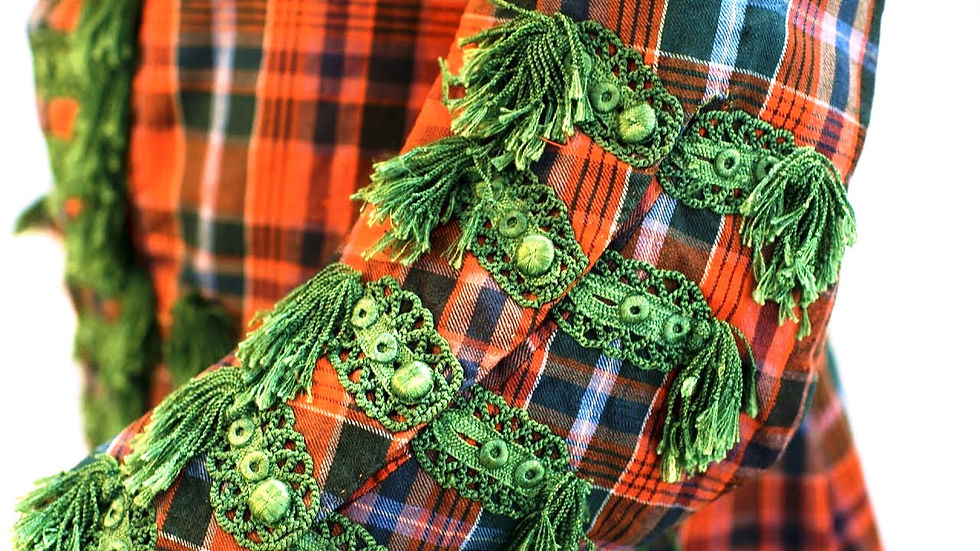The Jacobites and Britain 2: The Extent of English Jacobitism
- John Provan
- May 22, 2020
- 7 min read

Sir John Hynde Cotton was a Tory MP for 44 years from 1708 to 1752, representing at various times Cambridge, Cambridgeshire, and Marlborough. He has been called "one of the most zealous Jacobites in England". This is a photograph of his splendid tartan suit from National Museums Scotland.
The first article in this Series written by John Provan demonstrated how divided Scotland was by the Jacobite cause. We dismantled the myth that the Jacobite Risings could be crudely labelled as Scottish v English conflicts.
Our second article looks at the much-neglected, yet fascinating world of English Jacobitism; an intricate web of parliamentary factions, secret societies and a popular movement which would result in English regiments being raised for Prince Charlie in the '45, and ultimately lead some English Jacobites to take part in the fateful Highland charge at Culloden.
The roots of Jacobitism in England were deep and it commanded sympathy amongst some very high figures. The Archbishop of Canterbury William Sancroft was absent at the crowning of William and Mary on 11 April 1689, and the ceremony had to be performed by the Bishop of London in his stead.[1]
Some four hundred clerics and college fellows, including Sancroft and nine bishops, refused to take the new oath to William and Mary, and non-Juring Anglicans – those who refused to swear an oath of allegiance – would prove to be a consistent pool of support for Jacobitism.[2]
This was at a time when Westminster was divided along Whig and Tory lines, and some Tories remained loyal to the exiled pretenders. This was especially so after the Protestant Stuart line died out with Anne. Traditional Anglican Tories balked at the accession of the Lutheran German Electors of Hanover to the throne in 1714.[3] These Tories gave the Stuart pretenders a direct say in Parliament by taking instructions on how to vote and continually frustrated both their Whig opponents and those Tories willing to make peace with the new Hanoverian dynasty.[4]
English Jacobite Plots
This Jacobite influence in the corridors of power manifested itself in many clandestine plots. The Ailesbury Plot was organised over 1691-2 by a Jacobite network in South East England led by the Earls of Ailesbury and Melfort; the latter had been James VII's principal Secretary of State. They had planned for a French invasion headed by James VII, although it was thwarted after unfavourable winds left the French fleet grounded in its harbour.[5]
In 1695 English Jacobite Sir John Fenwick planned another French invasion with Louis XIV's ministers, yet it fell apart due to disagreements between the French and their Jacobite conspirators.[6] English Jacobites conjured up the Assassination Plot of 1696 which intended to murder King William while out in his coach, but was foiled when one of the plotters informed the government.
This sort of plotting by English Jacobites was evident right through to the Rising of 1745 (and indeed for a brief period afterwards). In 1743 a group of leading English Tories including the Duke of Beaufort, the Earl of Barrymore, Lord Orrery, Sir Watkin Williams Wynn, Sir John Hynde Cotton (see the video below) and Sir Robert Abdy sent a letter to Lord Sempill, the chief Jacobite agent at the French court in 1743.
They asked Sempill to approach the French government on their behalf with an invitation to invade England on behalf of the Old Pretender. French troops under the Protestant Marshal de Saxe were to join the Young Pretender and invade at Maldon in Essex, where they would join local Tories. An invasion force was fully prepared for February 1744, only for the worst storm of the century to ravage the French fleet, sinking several ships and forcing the rest back to shore.[7]
Popular English Jacobitism
English Jacobitism was not the preserve of disgruntled Tory MPs or the most traditionalist fringe of Anglicanism. There was a vibrant popular Jacobite scene in England; a cultural phenomenon that was a persistent feature of political life from the Glorious Revolution until the final rising in 1745.
Jacobite pubs like the Bull's Head in Manchester provided a social space to sing seditious songs, raise money for Jacobite prisoners and even sign up to fight during the Risings.[8] London hosted many well-known Jacobite clubs: the Cocoa Tree Chocolate House and the St. Albans Tavern and Coffee House in Pall Mall, the Half Moon Tavern and Coffee House in Cheapside and Ozinda's Chocolate House in St. James Street.[9]
On significant anniversaries there were running street battles in London between those who drank at the Jacobite taverns and their Whig opponents; this became such a phenomenon that the government went so far as to organise Whig 'mughouse' gangs to attack Jacobite haunts.[10]
A number of Jacobite newspapers enjoyed wide circulation throughout England. Between 1700 and 1712 it is estimated that around 70,000 Jacobite newspapers were sold each week.[11] Examples include 'Old England' which was edited by a 'Jeffrey Broadbottom'; 'The Champion' or 'Evening Advertiser' edited by a 'Captain Hercules Vinegar' of Pall Mall and 'Robin's Last Shift' by George Flint.[12]
There was also a proliferation of Jacobite poetry by the neo-Latinists at Oxford such as Alexander Pope's epic 'The Dunciad' and Archibald Pitcairne's 'Ad Carolum II'.[13] Meanwhile a network of secret societies like The Cycle of the White Rose and the Sea Sergeants served as Jacobite clubs, and indeed many other lodges and early freemason organisations had distinct Jacobite sympathies.[14]
There was also pro-Jacobite/anti-Hanoverian rioting within England, both during and in between the Risings. Historian Daniel Szechi notes that "plebeian Tories-cum-Jacobites in England expressed themselves far more vociferously against the Hanoverian regime in rioting throughout the winter of 1714-15, reaching a crescendo in the spring and early summer, than their Scottish counterparts."[15]
In the context of the 1715 Rising, there were running battles throughout Oxford that year after Jacobite ringleaders 'Mr. Boyce' and 'Mrs. King' were arrested and held at the Star Inn. A Jacobite mob gathered outside, refused to disperse and broke all the inn's windows; the city descended into chaos with many casualties on both sides.[16]
From June-August 1715 a riotous mob moved around Dudley, Oldbury and West Bromwich apparently directing their anger chiefly towards strongly anti-Jacobite presbyterians and dissenters, while one Birmingham mob led by the Wolverhampton town crier fired on guards and wounded several to stage a release of Jacobite prisoners.[17]
English Jacobites in the Risings
Northern England was the central stage for the Jacobite Rising of 1715. Thomas Forster, an English Tory MP who had been excluded from office the previous year served as the Commander-in-Chief of the Jacobite forces.[18]
Forster (a Protestant Tory), and the Catholic Earl of Derwentwater led a Jacobite rising within Northumbria and joined forces with Scottish Jacobites under the command of Brigadier-General William Mackintosh of Borlum. They enjoyed popular support in Lancaster, where the townspeople prevented Colonel Chartres from blowing up the bridge to stop their advance, and welcomed the Jacobites on their arrival.[19] Around 1,100 Englishmen had joined the ranks of the Jacobite army by November 1715, and upon their defeat at Preston the 463 English prisoners accounted for one-third of the Jacobite total.[20]
The Northumbrian Jacobites were a diverse force, with an almost 50/50 split along Protestant and Catholic lines.[21] The gentry were over-represented, yet we also know that weavers, butchers, wigmakers, innkeepers, smiths, farmers, joiners and in particular servants were amongst their ranks.[22]
Despite the rather romanticised and inaccurate stereotype of "the tartan-clad, bagpipe-playing Highland Jacobite", Northumbrian Jacobites would have appeared very close to this stereotype. Stonemason James Robson and George Shorer played the Northumbrian smallpipes at the head of a Jacobite band as they heralded the proclamation of James in several market towns. It's quite possible they would have been wearing Northumbrian tartan, which was commonly worn by pipers in the 18th Century.[23]
In the 1745 Rising, English Jacobites played a smaller, though still noteworthy role.
The evidence suggests that Manchester was solidly for the Jacobites. Whig families fled town upon the approach of the Jacobite army, while at Stockport the Young Pretender was greeted by "loud huzzas and demonstrations of zeal for his success".[24] They entered Derby to the tune of bagpipes while carrying St. George's flags. Amongst the locals who joined from the town was Edward Hewitt, a butcher who fought at Culloden and was later captured and executed.[25]
Wigan and Manchester were fruitful recruiting pools for the Jacobites. A 300-strong Manchester Regiment was raised under the command of Francis Townley. Although 118 of its men were taken prisoner on the retreat northward at Carlisle, some served to the end at Culloden.[26] Other Englishmen joined existing Jacobite regiments.
Perhaps the most remarkable case is that of John Daniel who joined on the road to Preston and served in Balmerino's troop of Lifeguards.[27] He took part in the actual Highland charge at Culloden and was able to smuggle away his troops banner after the battle - it bore the words 'Britons Strike Home'.[28]
Such stories are part of the rich tapestry of English Jacobitism, which contradict and demolish the Scottish nationalist myth that the Jacobite Risings were Scottish v English conflicts.
The next articles in our Series will expose the flaws in other myths surrounding the Risings, including the notion that they could be neatly divided along Highland and Lowland or Protestant and Catholic lines; or that the Jacobite armies were a backwards and almost anachronistic force fighting against Hanoverian Whig modernity.
Footnotes:
[1] Lord, E., The Stuarts Secret Army: The Hidden History of the English Jacobites, (Routledge, 2014) p.12
[2] Ibid.
[3] Szechi, D., The Jacobites: Britain and Europe, 1688-1788, (Manchester Univeristy Press, 1994), p.64
[4] Lord, p.41
[5] Szechi, p.55
[6] Ibid.
[7] Ibid., pp.95-6
[8] Ibid., p.25
[9] Lord, p.155
[10] Szechi, p.25
[11] Lord, p.148
[12] Ibid., pp.148-9; p.37
[13] Ibid., pp.142-3
[14] Szechi, p.25
[15] Ibid., p.75
[16] Lord, p.46
[17] Ibid., pp.47-8
[18] Ibid., p.71
[19] Ibid., p.80
[20] Pittock, M., The Myth of the Jacobite Clans, The Jacobite Army in 1745, (Edinburgh University Press, 2009, 2nd ed.), pp.56-7
[21] Gooch, L., The Desperate Faction? The Jacobites of North-East England 1688-1745, (CASDEC, 2001), p.60
[22] Ibid., p.61
[23] Ibid.
[24] Lord, p.200; p.205
[25] Ibid. p.209; pp.211-2
[26] Reid, S., The Scottish Jacobite Army 1745-46, (Osprey Publishing, 2006), p.23
[27] Lord, p.224
[28] Reid, p.28
Our Jacobites and Britain Series
2. The Extent of English Jacobitism
Please Support our Work
If you appreciate our educational work, please become one of our monthly Union Supporters who donate regularly to keep us going - from as little as £1.15 a week (£5 a month). You can donate monthly via Donorbox here
or you can donate monthly via PayPal, GoCardless or Bank Transfer here.
Or you can donate with a one-off payment at the PayPal link above or at this link.
Thank you so much if you can, and thank you to all the wonderful people who are already doing so.
























Comments